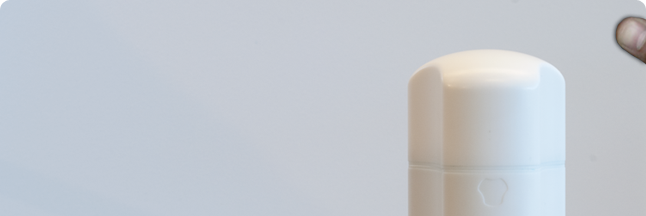A Tool called fluDOC
The final graduation project, executed at the Department of Industrial Design at the University of Technology Eindhoven. Titled Bioluminescence Design, this project showcases all the creativity and design skills gathered over the years are formulated into one single, purposeful product.
The product, called fluDOC, uses genetically modified bioluminescent bacteria to visualize traces of the influenza virus in humans. This is done using a tool collecting saliva and liquid capsules of these bacteria. The bacteria are specially modified to become sensitive to influenza, as they stop emitting their continuous flow of bioluminescence upon infection, ultimately visualizing within 15 minutes the presence of influenza among humans. In short: it allows you to illuminate your influenza.
The Thesis
The final thesis can be downloaded as a PDF here. Based on the attention to graphical detail and in showcasing the depth of this project it is recommended to take a look.
Press Pack
A Press Pack, containing numerous high quality pictures for web usage, can be downloaded as a ZIP here.
The Product
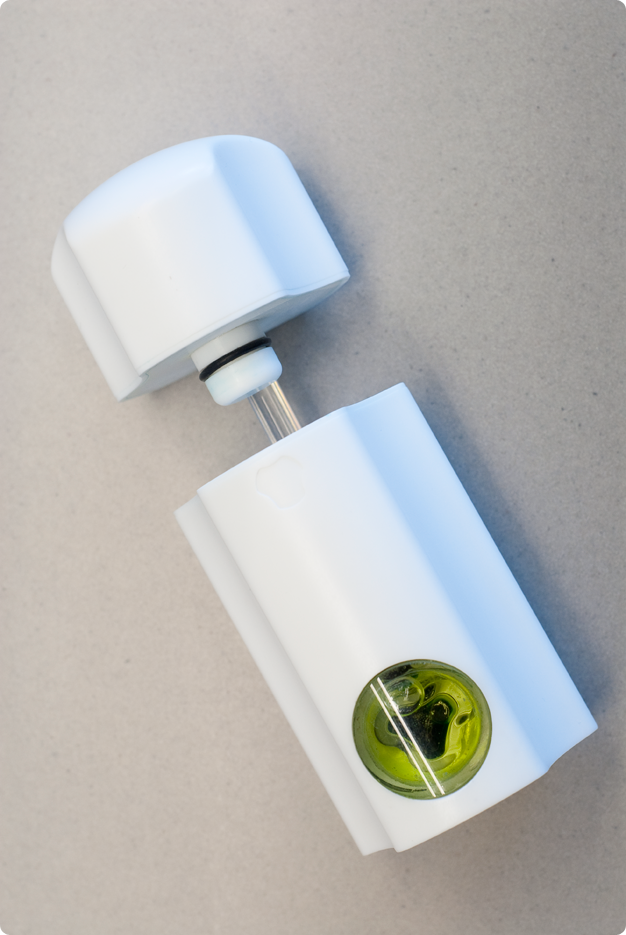
Interacting with fluDOC
An overview of the 6 interactions involved with the fluDOC diagnostic tool are found below, each with their corresponding description.
Interaction 1
Opening the product by removing the cap.
The opening interaction should be easy to understand for anyone without prior knowledge of the product. The opening interaction supports affordance by not only providing the user with the ability to pull the cap away from the body along the vertical axis, but also by turning the cap along the rotational axis.
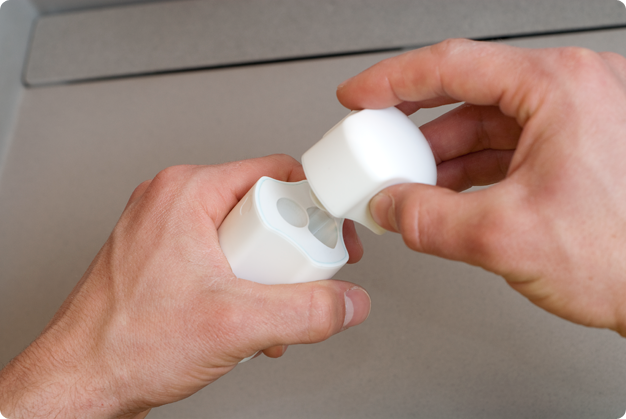
Interaction 2
Inserting the liquid capsule containing the bioluminescent bacteria.
After the product has been opened, the first step in performing the test is to insert the liquid capsule. With a considerable volume, the capsule is easy to hold in once’s hands. To exclude any confusion as to which shaft it is inserted, both the capsule and the shaft are colored green. The actual insertion aims to communicate a medical sensation.
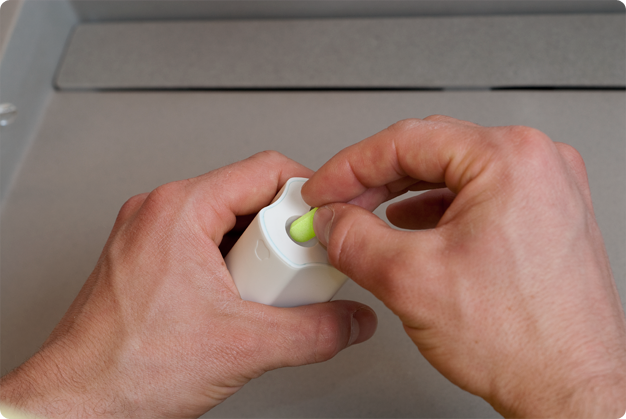
Interaction 3
Gathering the saliva using the saliva-stick.
Next up is gathering the tissue. The lollipop-shaped stick attached to the cap is inserted in the mouth to collect the saliva. To collect enough saliva, the stick should be rotated and moved inside the mouth for 10 seconds. The length of the stick allows for good penetration inside the mouth and the cap affords for a good grip inside the hand. By using glass, the stick obtains a more medical and hygienic character. The lollipop-shape affords towards oral usage.
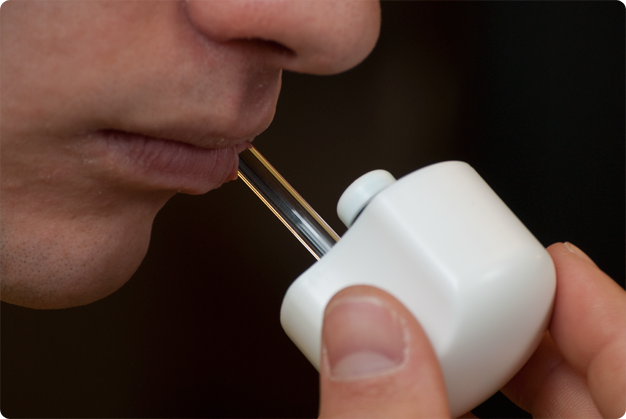
Interaction 4
Closing the product by securing the cap and puncturing the liquid capsule.
While both the opening and closing interaction in combination with the magnetic locking system provide the sense of a well locked product, the closing interaction is thoroughly guided by these same magnets. In addition, the magnets aid in the pressure needed to puncture the capsule and empty it into the reservoirs. The entire interaction is perceived as an easy one to perform.
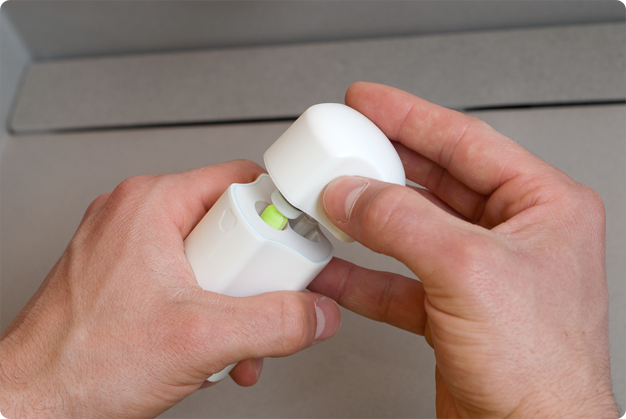
Interaction 5
Waiting and observing the test’s outcome.
During the time the product needs to fully complete the biochemical reaction, the user can perform other bathroom activities. After 15 minutes, the product ensures a completed reaction. To observe the outcome, the user can either watch the product’s observation window with the product standing on its feet or by picking it up.
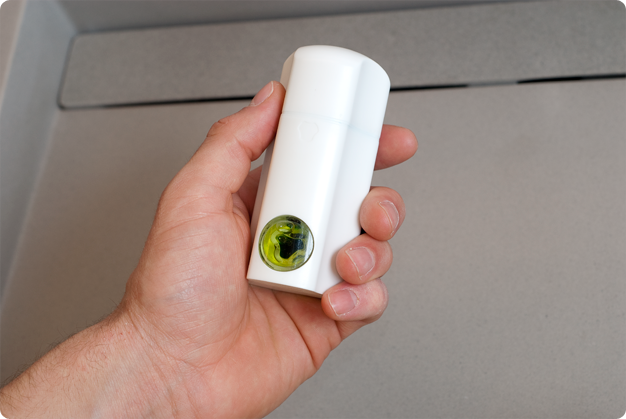
Interaction 6
Cleaning the product.
The last interaction in the process of using the product is the cleaning. Although a thorough rinsing with hot water will be sufficient, users might wish to use their dish washer to ensure an even better disinfection. This is easily accomplished by placing the opened product inside the dishwasher. Beforehand, the liquid capsule’s shell and bioluminescent bacteria will have to be disposed of in the sink.
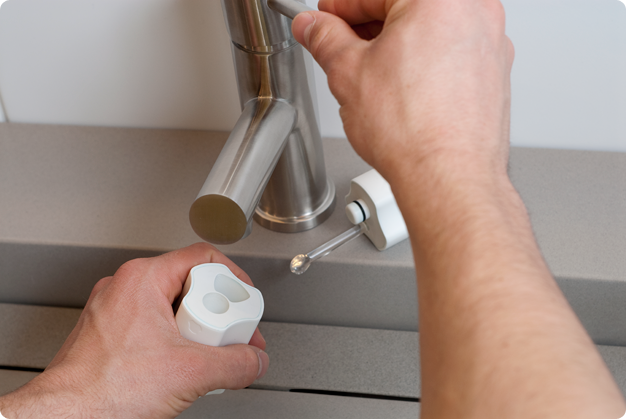

The Process
An abstract of the project containing an overview of the main phases of the project is illustrated below. To avoid publishing the entire master thesis in this format, all the phases refer to chapters found in the master thesis which can be downloaded as a PDF here. (The PDF is best viewed while displaying 2 pages side by side, a setting easily changed in every PDF viewing application under “view” in “pdf display.)
Fascinating Bioluminescence
The project started with a fascination towards bioluminesence; a form of “cold light” emission, or luminescence. This means that less than 20% of the light generates thermal radiation. Currently the list of bioluminescent life is quite large. Ranging from almost 90% of deep-sea marine life to various insects, worms, and larvae. Even numerous fungi are known to exhibit bioluminescent properties.
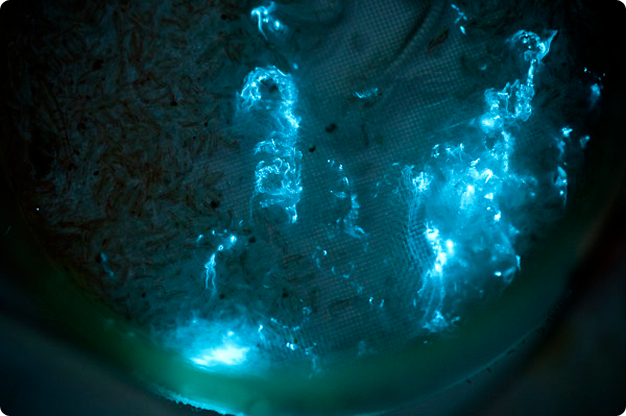
Bioluminescent Bacteria
The choice was made to us the bioluminescent bacteria species for their opportunities in the design process and constant illumination. Basically, it is yellowish illuminating liquid, able to glow for about 14-20 days in room temperatures. The bacteria species only need agar, a gelatinous-based growth substance, and oxygen to survive. Thesis: pages 14 – 25.
Concept and Genetic Modification
In conceptualizing this technology, thought was spent in searching a direction where the fascination of bioluminscence would be maintained, while the intended functionality would still create the necessary value and meaning to end users.
Using the knowledge these bacteria can visualize things we humans cannot see, a most suitable concept was formulated. If genetically modified, these bacteria could become sensitive to traces of the influenza virus. This would create the unique opportunity for accurate and fast diagnosis of an infection by the influenza virus.
Further iterations searched for accurate and preferred methods for gathering the needed tissue for the diagnosis. Users were confronted with various MDF models exploring these functionalities. Eventually the choice was made to utilize a method were saliva is gathered using a small stick which is moved around the inside of your cheeks. Thesis: pages 26 – 41.
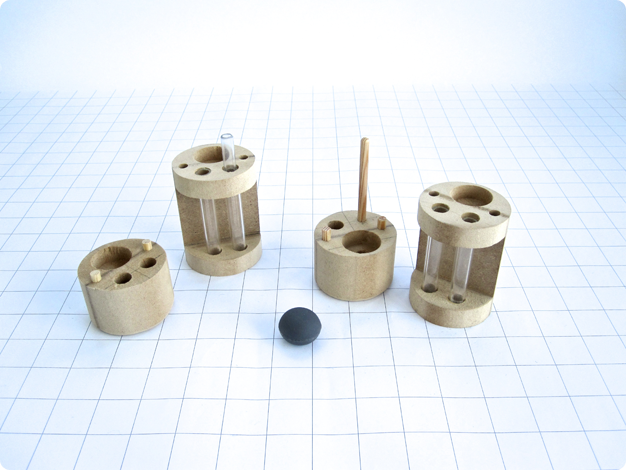
Synthetic Biology
the validation for various genetic modifications is based on a long range of technological advancements in the field of synthetic biology. These cases are documented in the thesis and have been communicated towards various experts. Thesis: pages 42 – 49.
These professionals stated that although the idea is feasible, it will take a lot of time and money to realize. The details surrounding the creation and introduction of such a technology and product are also documented. Thesis: pages 120 – 127.
Product Form
The next phase involved the creation of form. Various moodboards were used to determine the vital design aspects regarding the overal shape. When dealing with a hygienic product for holding in your hands, there are numerous details to consider. These characteristics include a more vertically-oriented form, subtle radii differences to optimize the touch and guide the eye along its curves, and delicate changes in dimensions to provide the product with a “face.” These principles were visualized using a series of sketches and finally in 3D using a sequence of MDF models.
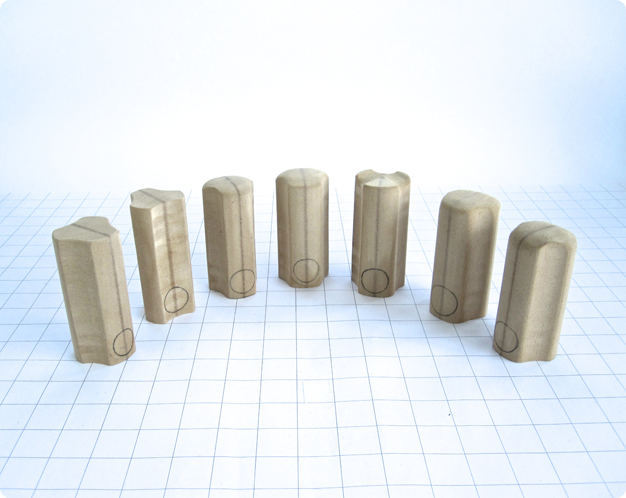
The Diagnostic Window
The design of a glass window were the diagnosis is visualized uses two compartments, a smaller chamber inside a larger one. The larger one acts as the control unit. The smaller compartment comes in contact with your saliva and will only become visible if you are actually ill. When traces of influenza are present within your saliva, the bacteria will die within 15 minutes. When this happens they will stop emitting light and change into a darker fluid compared to the control compartment, which still emits light in a brighter color.
Material
The chose material is CorianTM, a solid and very homogenous white plastic. Used in kitchen countertops, it is quite suitable for hygienic applications. Also, the increased density compared to most plastic provides the material with a certain “authority” towards the user. Thesis: pages 50 – 77.
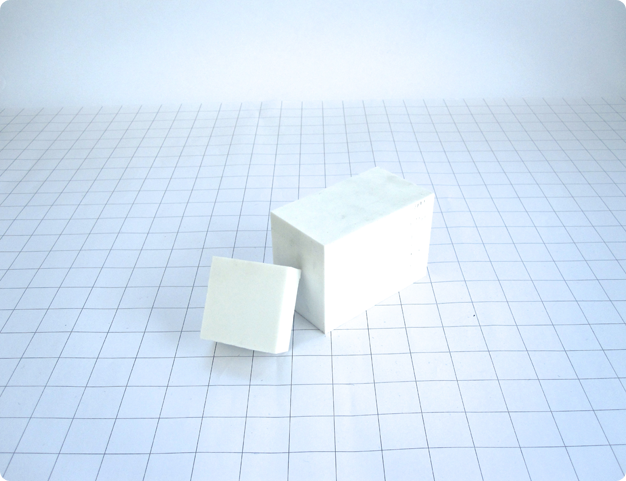
Magnetic Interaction
For the interaction of separating the cap from the body of the product, explorations were made using magnets. The goal of these magnets is to guide the interaction in as many ways as possible and create the feeling of a firmly closed product.
Various interactive MDF models explored these magnetic locking systems. The final iteration includes 6 magnets to keep the cap onto the body. While rotating the cap, the magnets come out of alignment, making the cap easy to separate. Also, a second set of magnets in the body rotated upside down push the cap off the body upon rotation. Thesis: pages 78 – 95.
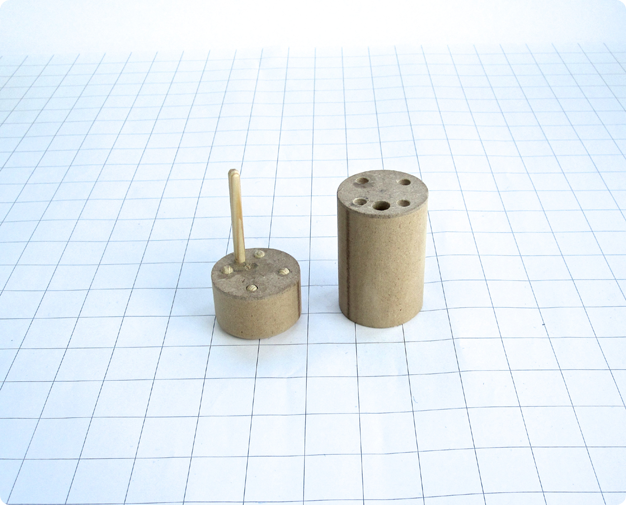
2D to 3D
All the design steps were translated into a 3D model. This 3D model visualized an overview of all the parts and also delivered the 3D model for the milling machine.
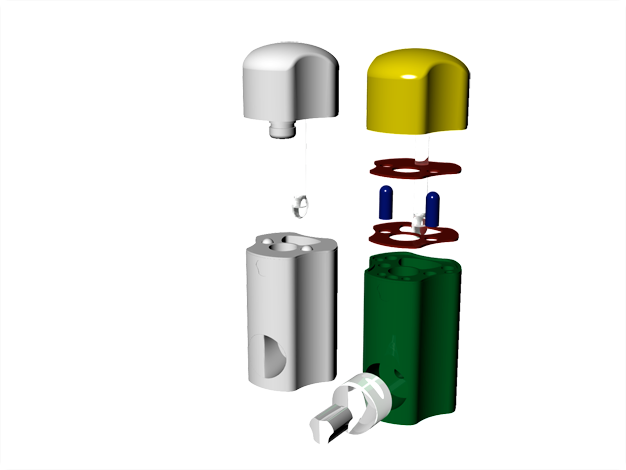
Manufacturing the Prototype
The final prototype was manufactured form a solid block of CorianTM using a 5-axis milling machine. The final result housed all the necessary cavities for the magnets.
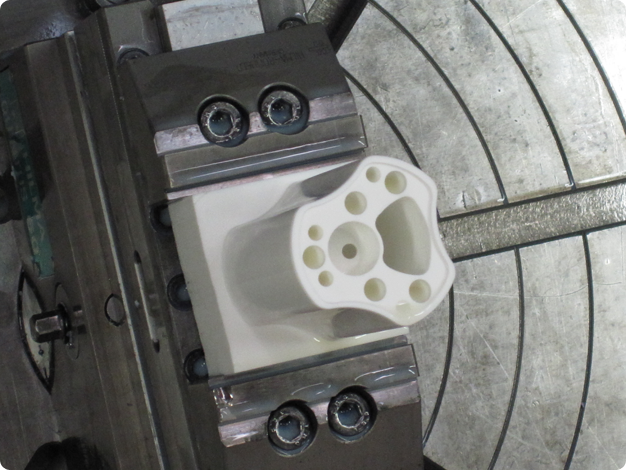
Assembly
Assembling the model included the insertion of a custom blown glass saliva stick with a lollypop-like tip and the custom blown glass compartments. Also, all the magnets were glued into place and covered using 1mm polystyrene plates laser-cut to size.
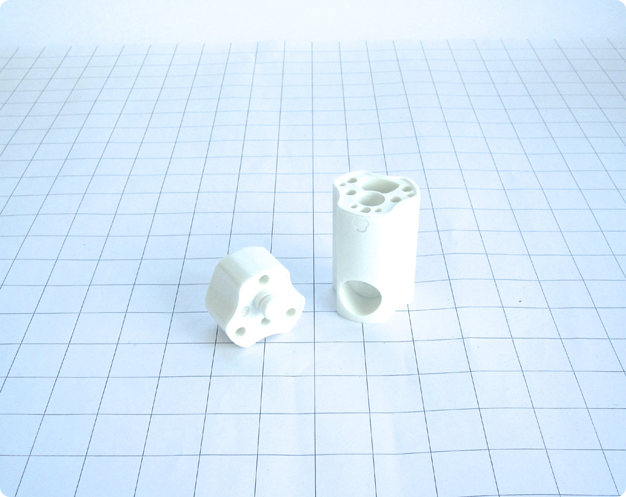
The Final Prototype
Finally, the model was polished and a bright liquid was added for demonstrational purposes since the actual gentically-modified bioluminescent bacteria were, obviouly, not available. Thesis: pages 96 – 119.
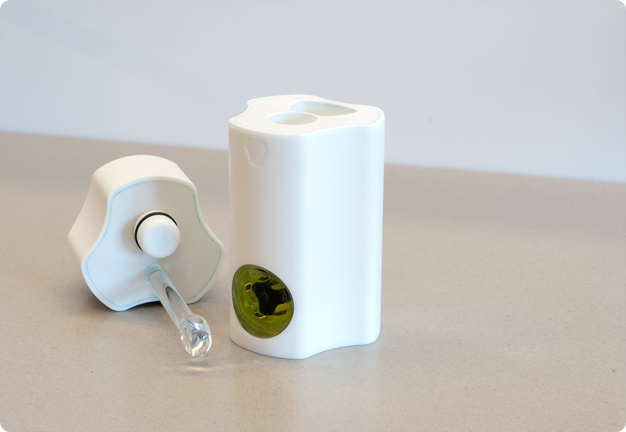
Conclusion
Also, the conclude the entire thesis, the main decisions were documented and discussed, as well as feedback from various professors in the fields of microbiology, virology, biochemistry, and synthetic biology. Concludingly, a view was given of the future developments of the fluDOC product, which much emphasis on the diagnosis of pandemic threats. Thesis: pages 134 – 143.
The final design, including the very broad thesis is a perfect testiment to my identity as a creative design wizard. It is a fitting end to my time at the Department of Industrial Design, showcasing my creative and design skills as well as my drive to deliver something unique and innovative to the table.
The Video
Additionally, a small video was shot for the E-Culture Fair 2010 in Dortmund in an project titled: “Out of Curiosity.” This set of videos showcases the road trip of Joël Rabijns where he explores the educational field of e-culture in Flanders, the Netherlands and Nordrhein-Westfalen. The video can be seen below, presenting an overview of the project, visuals, models, and final product.

Stats
completed in: April, 2010
time spent on project: 27 fascinating weeks and a lot of overtime
stakeholder: Department of Industrial Design
links: blogged at Next Nature, the Next Nature Lab, Yanko Design, Trendhunter Magazine, Idealize, Design Technologist, SolidNed, Existing Visual, Creativity Platform, TekGek, medGadget, NGanu, Biotech View, Gajitz, NuZakelijk, WebFroster, CreativityPlatform, CultureWaves, and CoproNed DuPont. Published in the Cursor (Dutch), discussed by Koert van Mensvoort in “Het Lab van Koert” on the Dutch Radio 1 (in Dutch)
exhibited at: the E-Culture Fair 2010 in Dortmund (23 – 25 August 2010), ID’10: the main exhibition of the Department of Industrial Design at the University of Technology Eindhoven during the Dutch Design Week (23 – 31 October 2010), and Next Nature’s NANO Supermarket Exhibition also during the Dutch Design Week (23 – 31 October 2010), at the NEMO Amsterdam (27 January 2011), at the Leidseplein in Amsterdam (28 January – 2 February 2011), in Pamplona Spain (9 – 14 March 2011), at the Evoluon in Eindhoven (17 March 2011), at the TEDxBrainport event Eindhoven (13 May 2011), during the Cultuur op de Campus event in Nijmegen (19 May 2011), at the Night of Art & Science Groningen (4 April 2011), at the Picnic Festival Amsterdam (14 – 16 September 2011), at the TU/eXperience (02 October 2011), and at the STW conference Nieuwegein (6 October 2011)
awards: finalist at the 2010 Designers and Artists for Genomics Award
